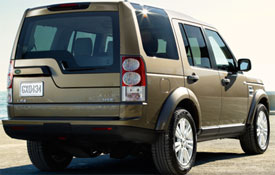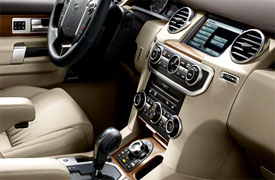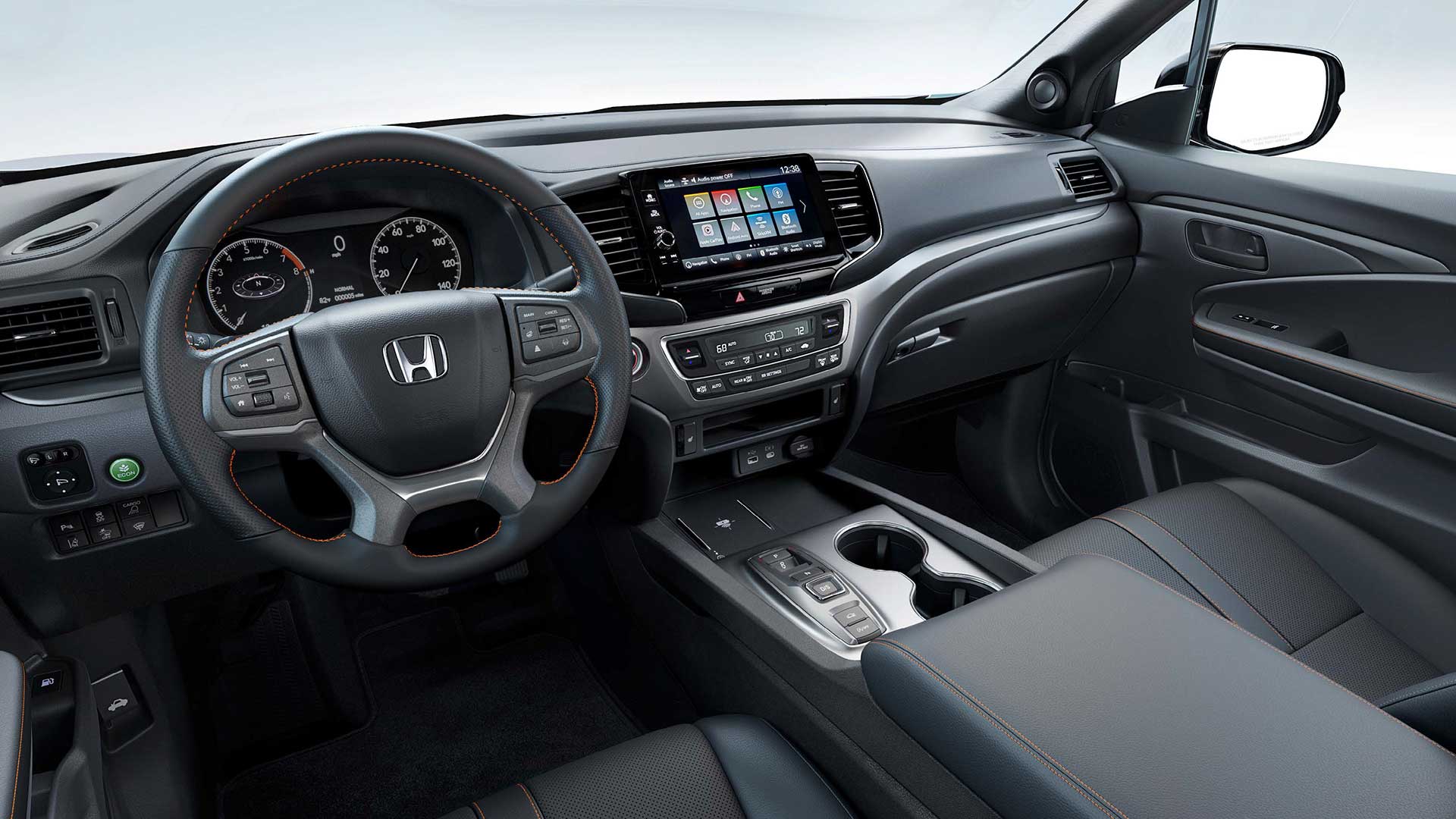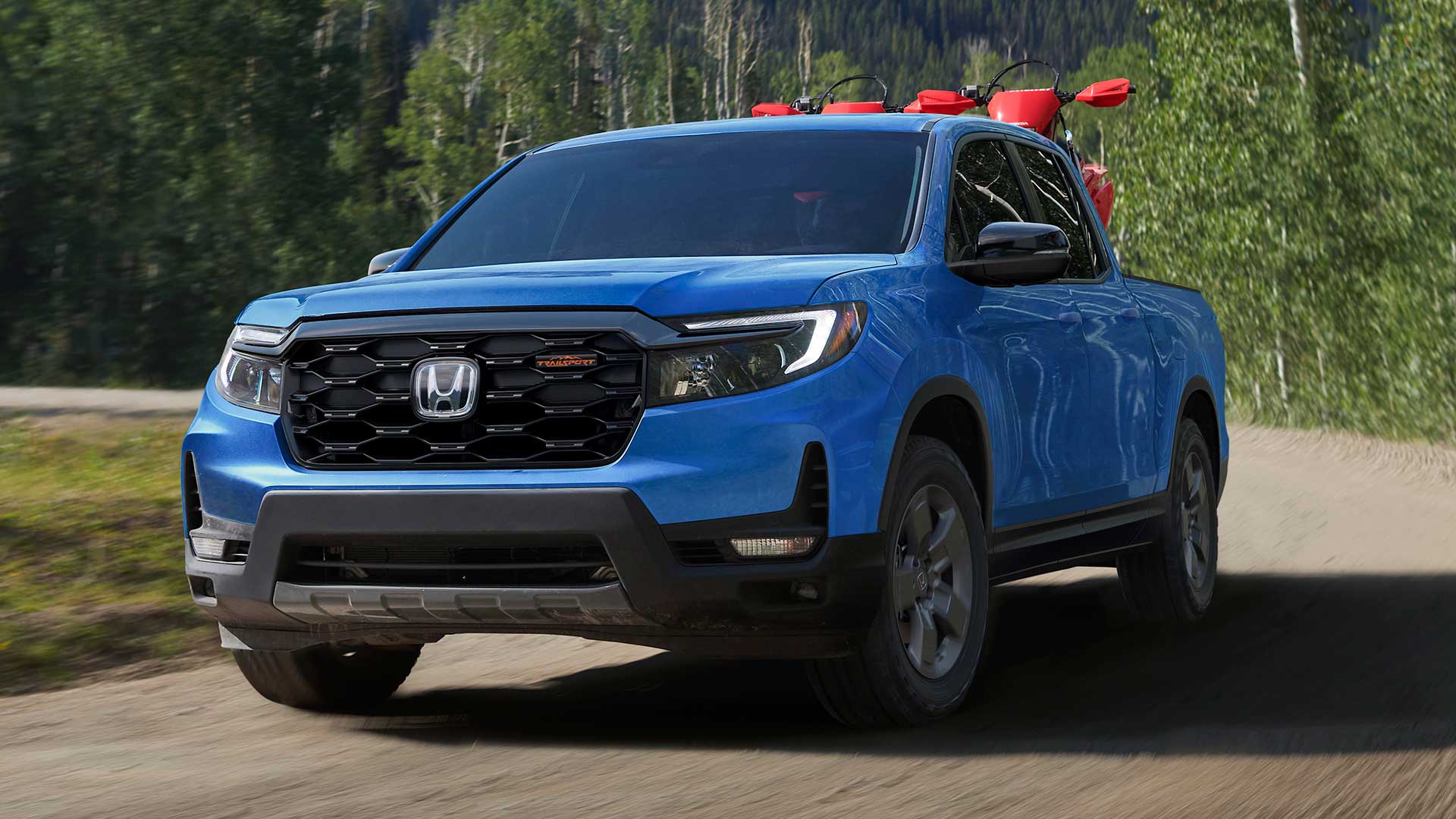2010 Land Rover LR4
While Range Rovers fit for royalty are the most prestigious products from Britain’s Land Rover, it is their rugged mid-size utilities that are most likely to be found in American driveways. Now to keep that loyalty, Land Rover routinely provides major upgrades. The stepped roof Discovery gave way to a more rectangular LR3 for 2005, and now five years in, designers deemed it time for a new engine, new technology, new interior, and a new name. The Land Rover LR4. Let’s see if all this change is a positive move.
You may not notice much of a difference between the 2010 Land Rover LR4 and its predecessor. It retains the LR3’s squared-off, stepped profile, as well as general size. New styling cues are subtle, like a more upscale front end, smoothed out and brought closer to the top drawer Range Rover. Lighting gains the latest fashion, strips of LEDs daytime running lamps.
The LR3’s lone fender port gets a twin on the LR4. The only place the outgoing model’s asymmetrical styling theme continues is the funky notch in the tailgate glass. Our Izmir Blue LR4 came shod with the new 19-by-8-inch alloy wheels. Twenty-inchers are optional.
 But there are bigger changes under the skin. Open the hood to a new all-aluminum 5.0-liter V8 rated at 375 horsepower and 375 pound feet of torque. That’s 25% more horses and 19% more torque than last year’s 4.4 V8.
But there are bigger changes under the skin. Open the hood to a new all-aluminum 5.0-liter V8 rated at 375 horsepower and 375 pound feet of torque. That’s 25% more horses and 19% more torque than last year’s 4.4 V8.
The only transmission is an upgraded ZF six-speed automatic with sport manual mode. We found it to be well-matched to the Rover’s added power. Shifts are smooth and satisfying.
Off-roading is at the core of Land Rover DNA, and the LR4 is the most intrepid vehicle in the Land Rover’s U.S. model range. Revisions to the sophisticated Terrain Response System provide a higher degree of versatility. Sand Launch Control is new, and Rock Crawl can now automatically apply the brakes in precarious low-speed situations.
Our biggest complaints with the LR3 were slow shifts and a lack of power at the top end, but the LR4’s V8 is smooth and torquey across its entire powerband. Zero to 60 is a fine 7.5 seconds, a half better than our last LR3. So, there is ample passing power for broken lines and yellow lights, and plenty of low-end grunt for steep grades.
The LR4’s other notable mechanical bits include a multi-setting electronic air suspension, new chassis components, and bigger brakes. Towing tops out at a capable 7,700 pounds. Our tester’s Heavy Duty Package includes a locking rear diff for when things aren’t going right, and a full-size spare.
We liked the view from the LR3’s airy cabin just fine, but the dash left quite a bit to be desired. For 2010, the center stack and console feature more ergonomically correct controls, and much more pleasant styling.
 Soft-touch materials are everywhere, from the dash pad, to the stitched multi-function steering wheel, to the leather-rimmed seats. Bolder seat contours make for a more comfortable cabin, too. Gauges remain large and clear, under a deep hood to protect from glare. Our HSE Plus adds satellite navigation, along with three-row, seven-passenger seating.
Soft-touch materials are everywhere, from the dash pad, to the stitched multi-function steering wheel, to the leather-rimmed seats. Bolder seat contours make for a more comfortable cabin, too. Gauges remain large and clear, under a deep hood to protect from glare. Our HSE Plus adds satellite navigation, along with three-row, seven-passenger seating.
We like the raised position of the second row split bench, although there could be more legroom. The third row, however, is hard to get to and really only suitable for small children.
One of the design features that gives the LR4 such off-road prowess is a short rear overhang. But that also limits luggage space. Open the split hatch for only 9.9 cubic feet behind the third seat. Fold it down for a more respectable 42.1 cubic feet, with a class competitive 90.3 after all seats are down.
Less respectable are Government Fuel Economy ratings of only 12 city and 17 highway on premium gas. The new V8 is just as thirsty as the old one. But, according to Land Rover, tailpipe emissions now meet ULEV2 regulations.
Still, the LR4’s Energy Impact Score is very high, 24.5 barrels of oil consumed annually, and leaves a 13.1-ton Carbon Footprint wherever it goes. Those numbers are the same as the Mercedes-Benz GL550, which doesn’t soften the environmental blow at all.
Yet given all it’s attributes and luxury, the base LR4 well priced at $48,100. That’s over $35 grand less than the GL550. Even the higher featured HSE at $51,750, and top-shelf LUX at $57,665, look good by that measure.
Land Rover’s new 5.0-liter V8 is a much better match for the LR4’s mass, and for 2010, Terrain Response is a good thing made better. That, plus a host of other improvements really do make the LR4 worthy of a new name, despite appearances. The LR4 upholds the Land Rover heritage well, adding more refinement and comfort, without losing any of its off-road moves.
Specifications
- Engine: All-aluminum 5.0-Liter V8
- Horsepower: 375
- Torque: 375 Lb Feet
- 0-60 MPH: 7.5 Seconds
- EPA: 12 MPG City/ 17 MPG Highway
- Energy Impact: 24.5 Barrels Oil/Yr
- CO2 Emissions: 13.1 Tons/Yr
2024 Honda Ridgeline TrailSport
It Does Truck-Like Things Better Than Ever
Honda brought something truly unique to the pickup truck scene when their mid-size Ridgeline debuted for 2006. In 2017, it moved towards becoming a little more true truck-like, both in form and capability, now with yet another step in that direction for 2024. So, let’s see if the Ridgeline is really hitting its stride.
For 2024, it’s all about making this Honda Ridgeline better than ever. There are styling tweaks outside, along with tech and functional improvements inside, but the biggest news is the Ridgeline has now joined Honda’s TrailSport family of off-road inspired vehicles. This more-true-trucklike, second-gen Ridgeline been around since 2017, receiving periodic updates over the years; but joining the TrailSport family is the biggest leap yet.
Primarily, the TrailSport transformation includes General Grabber all-terrain tires, mounted on new Pewter Gray 18-inch wheels, steel underbody protection, and retuning the strut front, and multi-link rear suspension for added wheel articulation. And while we always appreciate the additional traction of off-road tires, the Ridgeline’s standard i-VTM4 all-wheel drive, with Intelligent Traction Management and snow, sand, and mud settings, was already quite capable of handling all but the most extreme off-roading, ground clearance of just 7.6 inches being it’s only real hinderance.
A 3.5-liter V6 remains under the hood as it has since the Ridgeline debuted for 2006; the current version outputs 280 horsepower and 262 lb-ft of torque, plenty enough muscle to handle its 5,000-lbs. towing capacity. A nine-speed automatic transmission with paddle shifters and bevy of push and pull buttons on the console replaced the six-speed automatic back in 2020.
In addition to adding TrailSport capability, a big focus for this update was making it more user-friendly inside, starting with the central touchscreen growing from 8 to 9 inches. It also gets faster processing speeds, menus have been simplified, and the native navigation system is improved with better graphics. It’s accompanied by a new digital instrument cluster, along with an upgraded center console with more storage space. Unique TrailSport touches include heavy duty floormats, leather-trimmed seats, orange stitching throughout the cabin, and orange ambient lighting.
The Ridgeline continues to offer things available nowhere else in the pickup truck market.
Exterior styling doesn’t exactly shout “macho big rig coming your way,” but the more vertical face and larger grille that arrived for 2021, along with this year’s added TrailSport elements, do continue to toughen up the Ridgeline’s image. The 5’4” bed remains highly functional with no large wheel well intrusions, multiple tie-downs points, lighting and even speakers. And of course, the Ridgeline continues to offer things available nowhere else in the pickup truck market, like the dual-action tailgate, and large, lockable, drainable, underbed storage. Not to mention being able to drive around in true car-like comfort, something we took full advantage of on our way to our Mason Dixon Dragway test track.
There was great grip off the line, with full power arriving smoothly but quickly, helping us to get to 60 in 7.0 seconds flat, a tenth quicker than the last Ridgeline we tested. That power delivery stayed fairly consistent the whole way down the track, barely interrupted by the nine-speed automatic’s smooth shifting. Our best quarter-mile run was 15.5 seconds at 90 mph.

The revised suspension and knobbier tires didn’t really seem to add or detract from handling prowess, as it felt as solid, nimble, and car-like as it always has through our cone course. Perhaps a little less stiff than before, but good feedback, tight steering, and minimal body roll for a pickup, made for a very confidence inspiring experience. In our braking test, we stopped in a respectable average of 123 feet from 60, with only moderate amounts of nosedive and good feel through the pedal.
There is, however, a slight reduction in Government Fuel Economy Ratings with the all-terrain tires; 18-City, 23-Highway, and 20-Combined, our average, right on, at 20.4 mpg of Regular. That’s a slightly below average Energy Impact Score of 14.9 barrels of yearly oil use, with CO2 emissions of 7.4 tons.
TrailSport pricing falls in line just under the Ridgeline’s top Black Edition trim with a starting price of $46,375, about five grand over a base Ridgeline Sport.
So, whether you consider the Honda Ridgeline to be a “real” truck or not, this ruggedly smooth 2024 TrailSport does truck-like things better than ever. And we’re not just talking about the slight upgrade in off-road performance, we’re talking about a flexible bed to help you get chores done, and the ability to tow or haul with comfort and flexibility other trucks can only wish for. It’s why the Ridgeline brings more first-time buyers to Honda than any other vehicle, and why it continues to be a great choice in the growing midsize truck realm.
Specifications
- Engine: 3.5-liter V6
- Transmission: 9-speed automatic
- Horsepower: 280
- Torque: 262 lb-ft
- EPA: 18 City | 23 Highway | 20 Combined
- 0-60 mph: 7.0 seconds
- 1/4 Mile: 15.5 seconds at 90 mph
- 60-0 Braking (avg): 123 feet
- MW Fuel Economy: 20.4 mpg (Regular)
- Max Towing Capacity: 5,000-lbs









